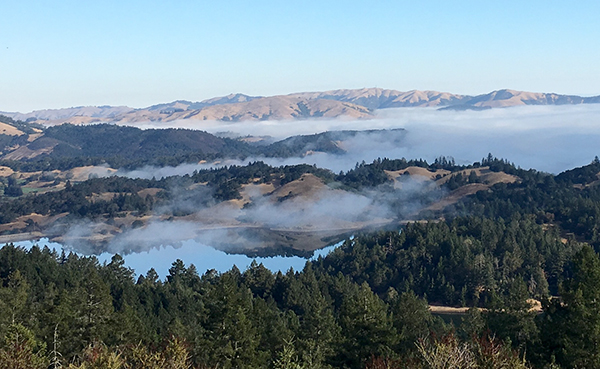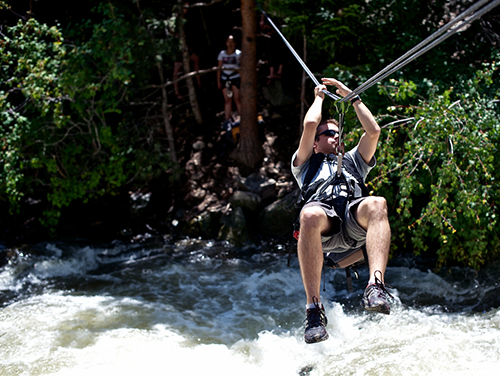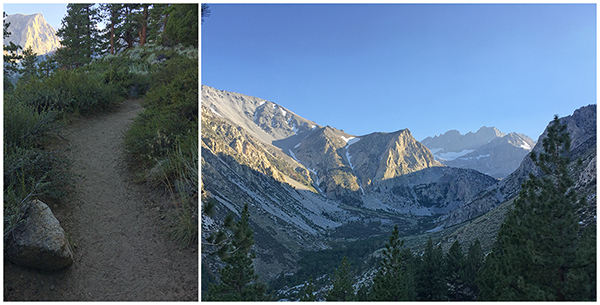November 1, 2017 – Making friends with challenge
- At November 01, 2017
- By Cara
- In Life Stories
 0
0

The view of Bon Tempe Lake I was rewarded with this past Sunday morning after huffing and puffing up a steep grade near where I live.
My hope and intention when I decided to hike 60 miles up and back to the summit of Mount Whitney this summer was to give myself a physical test. I wanted to know the strength in my body. Though it did take stamina and I ran out of energy on day 5 because I didn’t sleep well at the high elevation, the time spent hiking was pretty do-able. I’d trained enough and the relatively slow pace our guides set for us meant that I never found myself reaching the point where I wasn’t sure I’d be able to do it. That test came when I was in my early 20’s.
In the late 70’s, early 80’s my parents were quite involved with EST. They did the Training and The 6-Day which inspired my mom to offer to pay for any of her four kids who wanted to do these programs. It was September 1984 and I had just finished college. I still had my suntan from spending the summer with my boyfriend travelling with a backpack around Europe when I drove up to the 6-Day retreat center off of Mark West Springs Road in north Santa Rosa. (I wonder if it’s still there after the fires that just raged through that canyon?)
I remember very little about the time spent in the seminar room; what has stuck with me are the memories of the physical activities. Every morning we had to run a mile up and around a fairly steep road that circled the camp. Whether or not we were in physical condition to run, we had to pick up our feet, no walking, even on the steep part! There were people lining the sides of the road yelling at us not to stop. This was EST – so it was pretty intense! One day of the six was spent on a three-event ropes course: a zip line, a short rappel down a rock face and a Tyrolean traverse. I felt jitters standing on the platform before jumping off the zip line, but flying down to the field below was a completely thrilling experience. And I loved the rappel – I found it super fun and freeing bouncing back off the rocks. But the Tyrolean traverse pushed me in a way I’ve not been pushed – before or since.
A Tyrolean traverse is, according to Wikipedia, a method of crossing through free space between two high points on a rope. Hanging from the center of your body from the rope, you kick off across the canyon, head first, pulling yourself hand over hand on the rope above your head, feet and legs dangling. The first part was fun – an easy glide down. Across the middle it got a bit harder, but I did fine. The challenge came in getting myself back up the other side, using just the strength of my arms. This was so incredibly hard! I was convinced that I did not have the strength to do it.
Again there was the cheering/yelling section telling me to keep going – and to stop trying to use my feet to propel me along the rope – and to stop telling myself I couldn’t do this. I was pulling with all my might and I was going nowhere. Though I was not quite 23 years old and had just carried a backpack for three months, my arms just weren’t up to the task; my natural strength has always been in my lower body. Ultimately, I did do it; I remember sort of coming-to on the other side, amid the cheering of my group. But the act of actually pulling my body up that damned rope happened in a complete memory black-out. I ended up being very thankful that this was our group’s first event and it was all downhill from there (actually the other two events literally were all downhill!).
Reflecting on this experience more than 30 years later, I don’t feel a great sense of accomplishment. I do appreciate knowing that when pushed, I did do more than I thought I could, but I still find it sort of disturbing that it was so hard for me that I have zero memory of actually doing it. Possibly because I don’t remember feeling any sense of triumph, it wasn’t enough to have satisfied me that I am strong. I still felt the need for the Mount Whitney experience.
I stayed with my friend Stephanie before and after the Whitney hike. I got back to her place late in the afternoon on Saturday, the last day of the hike. All I wanted was to take a shower, to wash my filthy clothes and to rest. She worked part of the day on Sunday, so I spent some time writing about the experience to share with you. When Steff came home, she wanted to take me to where she and her puppy dog, Chumley hike. A short, steep drive back up to the eastern flank of the Sierra Nevada mountains near her house in Big Pine and I was hiking – again! With my hiking boots and poles, heading up a steep, switchback trail… I had just done 60 miles and 11,700 feet of elevation gain (and loss) and here I was the next day, hiking!
I remember saying to Steff that I felt differently about hiking uphill than before I started my training in the spring. I used to dread hills – voices in my head telling me: stop here, this is far enough, you’ve done enough – before I was at the top. These voices were constant! But after getting through many steep ascents, one step at a time, this shifted. I realized I had a new relationship with challenging myself.
Looking at all of this today, I see the contrast between these two experiences. With the Tyrolean traverse there was no reward other than having gotten to the other side. Whereas hiking hills nearly always ends in taking in a spectacular view – beauty is motivating! I was elated taking in the 360-degree view from the top of Mount Whitney. There was also a difference in the spirit of the support I was given. I didn’t find the cheering very helpful; I remember feeling like I was wrong for my wanting to give up – no understanding or even acknowledgement of it.
I wonder what would have happened if instead of yelling at me, the leader or someone I trusted had quietly spoken to me, honoring my struggle and then asked me to go deep inside myself and find the place where more strength than I knew I had was to be found. I bet I’d have remembered getting to the other side. I didn’t end up needing this kind of support from our Whitney guides – I chose to get myself through my exhausted hours on my own, but I witnessed them supporting others through hard spots – and the quality of the interaction – the kindness and connection with my fellow hikers – was loving and lovely.
Doing what’s hard is… hard. It’s a lot easier to not take on our challenges. And I’m convinced that doing so is what it means to be really alive. What I’ve learned from these physical tests applies to doing other things – like learning to paint and pushing ourselves to take on greater challenge with our art. The support and the environment so matters. It helps enormously to have the struggle normalized. We fantasize about our time painting that it will be pure bliss, immersed in the colors, watching the art take shape. There is some of that, but it comes with a lot of challenge mixed in. And this is ok. It’s good, actually. Otherwise you never scale a mountain or have the equal thrill of making art that astonishes you.
The idea, I’ve learned, is to become friends with challenge. This doesn’t mean that it’s ok for challenge to knock us on our ass – which isn’t very friend-like. Having compassionate support that keeps you in the game is key here. But we also can’t be friends with challenge if we avoid it at all costs – which is where being brave comes in. The nature of our friendship with challenge is quite individual. We each have unique needs from our friendships. It’s up to you to decide how much to take on and what kind of support you need. Drill-sergeant may be what does it for you!
Looking at challenge as a friend – or as a potential friend can shift everything. So, what challenge is before you? What challenge can you shake hands with and get to know better? I promise you (and myself) what we really want is found on the other side.
With my love and my brave – and in beauty,
Cara







